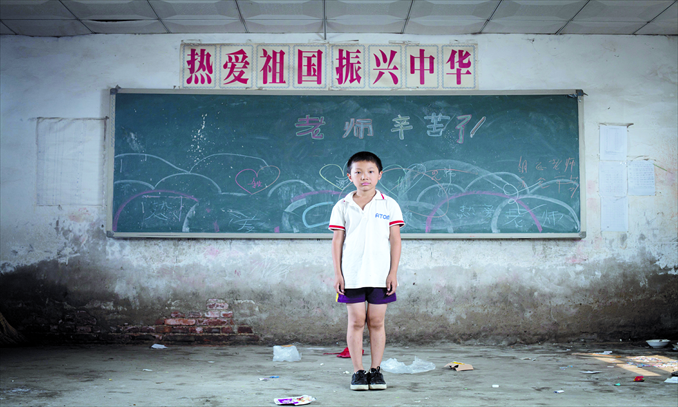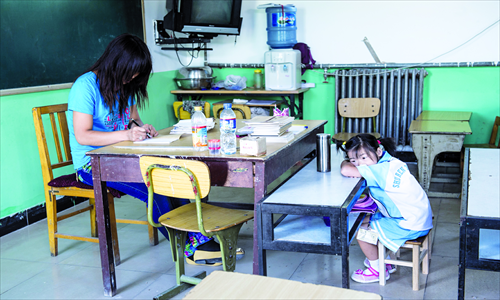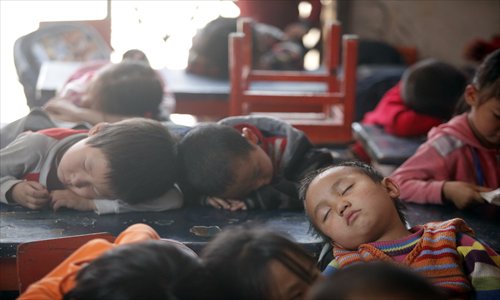School of hard knocks

Don't let your child lose at the starting line. This is a standard motto for Chinese parents, but for migrant children, even finding their way to the race is tough.
Shi Yujie, 16, found it hard to get accustomed to her new study environment after being admitted to Qinghe Middle School, Haidian district, where most students are from Beijing, She couldn't catch up with other students due to her poor performance in class, reported the Beijing News, and faced prejudice even from teachers.
One teacher told them, "You migrant students, don't seek self-inflicted setbacks," Shi reported to the newspaper. She was discouraged by another teacher telling her, children are like their parents.
In the end, Shi decided to go to another school only for migrant students because she felt more encouraged. "Everyone was born equal. Beijing is not just a city for Beijingers, and you [migrant students] must secure your future here, too," her teacher often told them.
Shi is one of the migrant students whose situation has become harder due to recent moves by local authorities.
In June 2011, about 30 schools for migrant children in Beijing received notices ordering them to close down. In the end, 24 of them were closed, depriving 14,000 students of the chance of an education, the Beijing News reported in late August.
Beijing schools for migrant children have dropped to 170, from a peak of 302 in 2008, according to Zhang Zhiqiang, a founder of Migrant Workers' Friend, a NGO aiming to protect migrant workers' rights.

Hard situation
According to the 2012 Report on the Development of China's Floating Population, China's floating population had reached almost 230 million by 2011, accounting for 17 percent of the total. Among the migrant workers in Beijing, Shanghai and Guangzhou, over 60 percent have their kids with them.
The government has promised not to force any migrant child out of school after closing down some private schools. But for Zhang, this is not the case.
According to a survey conducted by his organization, about 80 percent of migrant children are of elementary-school age, and 20 percent are junior high school students or older. Most of those fortunately admitted to public schools are kids who are older than Grade 4.
"It's better to escort children younger than Grade 4 to school and back home, but their parents are too busy with work to fetch them, and the places migrant workers live in are usually far from public schools," Zhang told the Global Times, adding that some children have no school to go to, and are either out of school or are forced to go back to their hometown. Even for those who get into a public school, life is not easy, like Shi.
Playing catch up
Shi's experience is similar to that of Wang Shufang, whose friends once told her of the inequality their children suffered in public schools studying alongside students from Beijing.
"A migrant student was even asked by the teacher to show a proof of mental health because of their poor school performance," said Wang to the Global Times, adding that some of her friends had to send their children home after being unable to find a school in the capital.
Wang, who works in finance and comes from Hebei Province, is lucky because her 12-year-old son is now studying in Grade 6 at Jushan Primary School in Beijing's Haidian district.
"I think my son is enjoying the same treatment as Beijing children, and teachers here treat every child equally," she said, adding that President Hu Jintao visited Jushan on Children's Day in 2009.

But in reality, the gaps between parents of city children and migrant children are growing.
Once in a parents' meeting when students were playing musical instruments, some parents were surprised and asked me what their children were playing, recalled Wang Yaping to the Global Times, the headmaster with Jushan.
Once a class contains what they feel to be too many migrant children, parents with Beijing hukou (household registration) will use various excuses to move their children to new schools, one headmaster from another school told the Global Times.
"Some parents want their children to be in a class with students who have similar or better backgrounds," he said, adding that this is the real condition on the ground despite the veneer of equality.
Obstacles for integration
Zhang Zhiqiang agreed with the headmaster as he is against migrant students studying together with Beijing students. He doesn't think the solution is to let Beijing's public schools take on more migrant children, something they are often unwilling to do.
"Public schools think their resources are 'shared' too much. Education fees from the central government are allocated to each province where those children's hukou are, but they get educated in Beijing," said Zhang.
While to Wang Xuming, former spokesman with the Ministry of Education, this shouldn't be an excuse to "refuse" migrant students entry into public schools, because the government states clearly that migrant students' education should be "cared" for by the city the parents work in.
"When a city [like Beijing] benefits from the work of migrant workers, it definitely cannot turn a blind eye to their children's education," Wang told the Global Times.
Furthermore, developed regions usually get a higher education budget than less developed ones, said Li Wenli, deputy director with Peking University's School of Education.
"The disparity in average education budgets for each student on compulsory education is as high as seven times between eastern provinces and central or western regions," Li said in a education seminar hosted by People's Daily in March.
As to migrant students' education, public schools, where a few migrant students studying with most Beijing students, are "cautious," and access to them by the Global Times proved hard.
"Why do you choose our school? We have only very few students from outside Beijing, just several kids in every grade and most of their parents are not migrant workers," the headmistress of the No 2 Gucheng Primary School, Shijingshan district, surnamed Wang, told the Global Times angrily by phone.
"If you ask public schools how many migrant children they have admitted, they would be willing to tell you. But when you want to know how those children are getting along with city children, suddenly it becomes sensitive," Wang Chunhua told the Global Times.
Wang is responsible for the teachers' program at the Beijing Rural Children's Cultural Development Center, which is aimed at advancing social equality and sustainable development.
"We have always wanted to know how migrant kids are doing in public schools, but none of the schools let us in," sighed Wang.
Recent events proved the difficulty of distributing high-quality educational resources between top schools and normal ones, let alone sharing resources between migrant and city children.
After Renda Fuxiao, the primary school attached to Renmin University, took over a nearby primary school, Yinyan Primary School, and enrolled more students, it has no enough space and decided to move Grade 5 pupils, about 700 of them, to Yinyan's former location.
However, the plan ended up failing because parents protested, saying the conditions in Yinyan were too poor to be suitable for their children. Yinyan is a public school, and it once enrolled migrant children before being taken over by Renda Fuxiao.
Besides, migrant children and urban children grow up in completely different environments, which adds to teaching difficulties. Some migrant children can not help comparing their life with their peers, which is not what their parents want, said Zhang, adding that in some schools migrant children are still "grouped" into a separate class.
Also, when school is over, some migrant workers don't have time to pick up their children, which is also a problem for public schools, said Zhang.
Finding solutions
Nevertheless, Wang holds a different opinion. She strongly proposes that migrant children should be admitted to public schools to study with other students. Compulsory education is guaranteed by law, and migrant children have the right to finish 9 years of equal education.
She said it doesn't contradict the popular statement that education should be diversified. "First there should be enough public schools to accept migrant children, and then private schools can be a complement," said Wang to the Global Times.
Public primary schools in Beijing decreased from 1,387 in 2005 to 1,136 in 2010, but primary-age students increased by 153,000 in that same period.
While in Shanghai, more public schools are set to enroll migrant students and non-profit private schools get compensation from the government if they do so.
Shanghai initiated a three-year plan in 2008, to let 70 percent of elementary-school age and all junior high school students study in public schools by 2010, reported China Youth Daily in August 2011.
According to a survey, conducted from 2009 to 2010, which followed 500 students from 10 schools for migrant students in either city, almost all migrant students who stayed to study in Shanghai were admitted to public schools or non-profit private schools.
While in Beijing, most students continued to study in schools specially for migrant students, according to China Youth Daily.
An investigation conducted by Beijing News shows that 53 percent of migrant children in Beijing continue to study in schools for migrant children. Over 30 percent have left for their hometown, and only 13 percent have been admitted to public schools.
Other problems wait for children who return home. They were born in Beijing, and some don't understand local dialects, said Zhang. "Also, they change from migrant children to left-behind children, which is also a serous social problem," he said.
Statistics from the Ministry of Education shows that the number of schools in the countryside in 2010 is nearly half of that of 2001.
Wang Chunhua emphasized that the first step, a very important and positive one, is for migrant children to be admitted to public schools. "No matter what problems are there, we must go on. It's also the first step toward eliminating discrimination," she said.